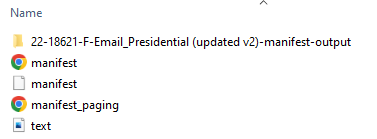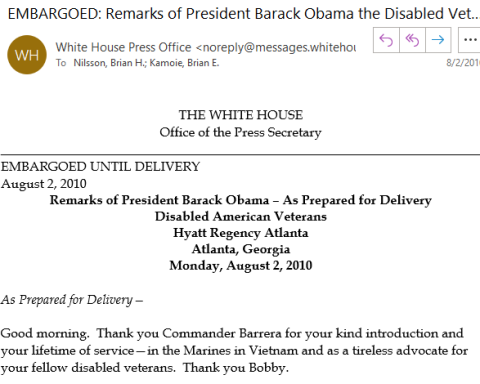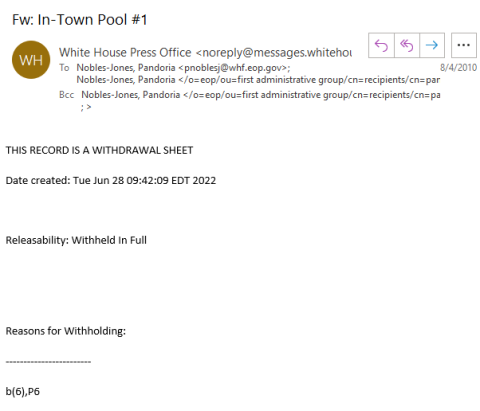On This Page
- Rendering Links ...
Electronic Records Guide

(P042409PS-02970)
The Electronic Records Archive (ERA) system is used to store and process electronic records from the Barack Obama Administration. The Executive Office of the President (EOP-ERA) version of the system exclusively stores presidential records.
Electronic records, such as emails and shared drive files, were ingested into EOP-ERA at the close of the Obama Administration. EOP-ERA 44 currently holds:
- 250 TB of data
- 300+ million electronic records indexed and available for search, including:
- 200+ million e-mail messages
- 3+ million digital photographs
- 30+ million other electronic records
Organization of Records
Electronic records from the Barack Obama administration are preserved within EOP-ERA in groups called “Search and Access Sets” (SASes). Records are grouped in a SAS based on the system that originally created the records. There are multiple email SASes, as well as other SASes created by additional electronic data systems used for photograph organization, scheduling, correspondence management, and other functions.
Primary Search and Access Sets (SASes):
- Exchange Email – Presidential and Exchange Email – Other: Exchange was used as the White House email system through the whole Obama administration
- Worker and Visitor Entry System (WAVES): WAVES contains records of visitor entry to the White House complex.
- White House Photo System: The White House Photo System contains digital images and their associated metadata.
EOP-ERA also contains files from hard drives on White House computers, including home drives maintained by individual staffers and shared drives used across White House offices.
Primary Hard Drive locations:
- CEA (Council of Economic Advisors)
- NSC (National Security Council)
- OA (Office of Administration)
- OPD (Office of Policy Development)
- PFIAB (President’s Foreign Intelligence Advisory Board)
- WHO (White House Office)

Viewing Electronic Records
Electronic records may be downloaded via the Digital Research Room on the Barack Obama Presidential Library website.
Currently, electronic records are exported from the EOP-ERA system in packages organized by SAS. Records are exported in various formats, including PDF, EML (if the original files were email records), or the original file format (such as .doc or docx, .xls or .xlsx, etc.)
Email is defined as discrete electronic communications transmitted over the Simple Mail Transfer Protocol (SMTP), between two or more people or entities, in compliance with applicable IETF’s Request for Comments (RFC) specifications. Please note that NARA considers email attachments to be a component of the email record.
NOTE: Researchers may need to download additional software or file viewers to be able to open certain files. The Obama Library maintains and provides files in their original format, wherever possible. To learn more about electronic file formats, visit the Federal Records Management Files Format page.
Export Package
Records are exported in one folder. This folder is titled using the name of the original Search and Access Set (SAS).

The top folder contains the actual electronic records. Each record is named by its Asset ID number. (This unique number is used within the EOP-ERA system to identify each separate record.) Because Asset IDs are assigned randomly, the records within the folder are not organized chronologically.
Records within this folder may be in various formats:

Each file has an extension at the end of its filename that explains its record type:
- Files that DO NOT end in RV or WS: These files are electronic records that have been released in full – meaning they contain no restrictions or redactions. The file may have a file extension indicating its format, or it may only have a file name and no obvious extension.
Sample email record:

- Files ending in “_WS”: The “WS” in these filenames indicates a “Withdrawal Sheet." If an electronic record has been restricted in full or redacted under either the Presidential Records Act (PRA) and/or Freedom of Information Act (FOIA), it will have a corresponding withdrawal sheet which lists all codes under which the record (or portion thereof) has been closed. (See the below list of PRA restrictions and FOIA exemption codes.)
Sample Withdrawal Sheet:

- Files ending in "_RV": The "RV" in these filenames indicates a "Redacted Version." The redacted version will be a duplicate of the original record where the portions of restricted information have been sanitized. Each redacted section will be labeled with a code that explains the reason why the information has been redacted. (See the below list of PRA restrictions and FOIA exemption codes.)
Sample Redacted Version:

NOTE: If an electronic record has a “Redacted Version,” it will also have a
corresponding Withdrawal Sheet within the “representation” folder. The
Withdrawal Sheet will reiterate the PRA restriction or FOIA exemption code
cited as the reason for redacting a portion of the record. These two files can be
distinguished by the ending of the filename:

The package also contains two files titled “manifest.” The manifest is a list of every
electronic record contained in the package, as it was exported from the EOP-ERA
system. The manifest is presented in two formats: XML and HTML. (Both manifest files
will likely open in the computer’s default web browser.)
● The XML manifest provides additional metadata about the overall package of
records.
● The HTML manifest provides information about each record. The “Record File
name” corresponds to each file in the file folder. The “Releasability” decision
is also listed for each record. If a Withdrawal Sheet or Redacted Version was
created, the HTML manifest will list the filename of each.
NOTE: While the HTML manifest formats so that some of the filenames appear as hyperlinks, these
links will not work.
The package contains two additional files – manifest_paging (HTML) and text (GIF) –
that are necessary for the creation and function of the package, but do not provide any
added benefit to researchers.
Access to Electronic Records
All Obama Presidential records (both electronic and textual) are processed and reviewed for access under the provisions of the Presidential Records Act (PRA) of 1978, as amended, (44 U.S.C. §§ 2201- 2209), which incorporates the Freedom of Information Act (5 U.S.C. § 552) in substantial part. Records may be exempted from release – either in whole or in part – in compliance with the restrictions of the PRA and applicable FOIA exemptions, which specify what material may be released to the public.
PRA Restrictions and FOIA Exemptions Codes:
Presidential Records Act – [44 U.S.C. §2204(a)]
- P1 – National security classified information [(a)(1) of the PRA]
- P2 – Relating to the appointment to Federal office [(a)(2) of the PRA] • P3 – Release would violate a Federal statute [(a)(3) of the PRA]
- P4 – Release would disclose trade secrets or confidential commercial or financial information [(a)(4) of the PRA]
- P5 – Release would disclose confidential advice between the President and his advisors, or between such advisors [(a)(5) of the PRA]
- P6 – Release would constitute a clearly unwarranted invasion of personal privacy [(a)(6) of the PRA]
Freedom of Information Act – [5 U.S.C. §552(b)]
- (b)(1) – National security classified information
- (b)(2) – Release would disclose internal personnel rules and practices of an agency
- (b)(3) – Release would violate a Federal statute
- (b)(4) – Release would disclose trade secrets or confidential or financial information
- (b)(6) – Release would constitute a clearly unwarranted invasion of personal privacy
- (b)(7) – Release would disclose information compiled for law enforcement purposes
- (b)(7)(a) – Release would disclose information concerning pending or prospective law enforcement proceedings
- (b)(7)(b) – Release of information would deprive a person of a right to a fair trial or an impartial adjudication
- (b)(7)(c) – Release of information could reasonably be expected to constitute an unwarranted invasion of personal privacy
- (b)(7)(d) – Release of information could reasonably be expected to disclose the identity of a confidential source, including a State, local, or foreign agency or authority or any private institution which furnished information on a confidential basis, and, in the case of a record or information compiled by a criminal law enforcement authority in the course of a criminal investigation, information furnished by a confidential source
- (b)(7)(e) – Release of information would disclose techniques and procedures for law enforcement investigations or prosecutions, or would disclose guidelines for law enforcement investigations or prosecutions if such disclosure could reasonably be expected to risk circumvention of the law
- (b)(7)(f) – Release of information could reasonably be expected to endanger the life or physical safety of an individual
- (b)(8) – Release would disclose information concerning the regulation of financial institutions
- (b)(9) – Release would disclose geological or geophysical information concerning wells
Additional codes:
- Court Sealed – Records with the notation of “court sealed” remain closed due to the rule of a specific court case.
- Personal Record Misfile (PRM) – Records withheld under this category have been determined to be personal records, and therefore not legally subject to the Presidential Records Act.
Preferred Citation for Electronic Records
Email:
Email To, Email From, Email Subject, Date (mm/dd/yyyy), CC (if any), Collection/SAS. Barack Obama Presidential Library, National Archives and Records Administration.
Photographs:
Filename/frame, Date (mm/dd/yyyy), Collection/SAS. Courtesy Barack Obama Presidential Library, National Archives and Records Administration.
For more information on citing sources from the Barack Obama Presidential Library, visit the National Archives Research Our Records FAQ page.
